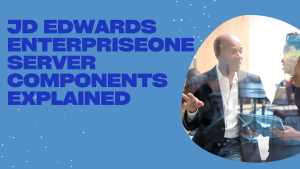JD Edwards EnterpriseOne Server Components Explained
Take Advantage of All Components of JDE EnterpriseOne with GSI

The components of the JD Edwards EnterpriseOne server lie at the heart of the JD Edwards (JDE) system. Each JD Edwards server component has a distinct role, and they work together to deliver a smooth, efficient process for admins and users. However, it can be a challenge to discern what each component does, which makes it hard to understand their implications for your workflow.
We will outline what each of the JD Edwards EnterpriseOne servers does.
Key terms to take note of:
- Server: a program or device that provides data and instructions to another program (client)
- JSON: JavaScript Object Notation—a data format used with elements of the JavaScript computing language. JSON makes it easier to send data in web applications
- REST: Representational State Transfer—a software architectural style that makes it easier for computers to share information on the internet
- Object: a set of code that does something the user wants
- Batch processing: a way to run software that automatically executes groups of jobs
- HTML: HyperText Markup Language—a language used to structure and create paragraphs, links, attributes, and tags within the content of a web page.
Enterprise Server
The enterprise server, also known as JD Edwards’ logic server, is where JD Edwards runs. It consists of executable objects—or blocks of code—that perform specific tasks for the system. The enterprise server can also scale and include more than one server, if necessary.
The enterprise server also manages security, handles batch processing, oversees how different JDE elements interact with each other, and more.
Web/HTML Server
The JDE web server is the user interface layer of the application. This is what your web browser connects to while you run JD Edwards. It feeds information to the user in a format that’s easy for humans to read. Without this server, it would be impossible for human users to interact with JDE.
Database Server
JD Edwards stores tons of information—on databases—that the different elements of the application required to perform tasks for users. The database server manages all this data, including the frameworks and functions necessary to provide data to the rest of the system. This makes it possible for the information you enter into the system to be pulled up and used later, for example.
Deployment Server
The deployment server is what sends code out to the end-user, including application code, patches, databases, and package builds in files. If you think of your JD Edwards application as a house built of many components and appliances, the deployment server is like a hardware store that sends the components needed to build the house and make it livable.
BI Publisher Server
The BI Publisher server manages the JDE BI Publisher feature. With BI Publisher, you can create reports and documents, distribute them via email, and build layouts you can use to disseminate information. The BI Publisher server is where the processes that make all this possible live and breathe.
Mobile Server
JD Edwards gives users the ability to perform a variety of tasks on mobile devices, including Apple, Android, and Blackberry phones and tablets. The mobile server manages the data and processes needed to enable mobile users to take advantage of services such as:
- Expense reports and their review and approval
- Purchase orders
- Requisitions and their review and approval
- Historical sales orders
- Queries regarding prices and the availability of items
AIS Server
The Application Interface Services (AIS) server facilitates communication between JDE EnterpriseOne and the wide range of applications and devices it works with, known as AIS server clients. In other words, the AIS server acts as a bridge between JDE EnterpriseOne and the apps and devices that use it.
Transaction Server
The transaction server manages all the messages that get sent between the applications within your JD Edwards implementation. In a large software ecosystem like JD Edwards EnterpriseOne, a lot of communication has to happen between different components and systems. If these could be compared to people that need to talk to each other, the transaction server is like the phone company that ensures they can interact.
Business Services Server
The business services server makes it possible for JDE EnterpriseOne to create and interact with web services, which enable applications to communicate with each other over the internet.
Server Manager
To put it simply, the server manager controls and monitors servers. It can be either installed on the deployment server or run on its own. It’s also used to view logs that record activity within JDE, as well as manage tool upgrades, software releases, and HTML.
Take Advantage of All Components of JDE EnterpriseOne with GSI
GSI’s team of JD Edwards managed services experts understands how all JD Edwards servers work together to help your business run more smoothly. As professional JD Edwards consultants, GSI’s team can guide you through the installation and implementation of your system. This way, you don’t have to worry about the interactions between servers and the business processes they enable.
GSI’s experienced pros will also help you decide the most effective way to leverage your JD Edwards implementation. Learn more by connecting with GSI today.
